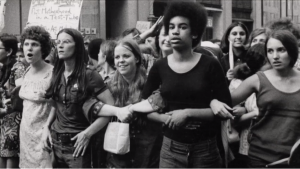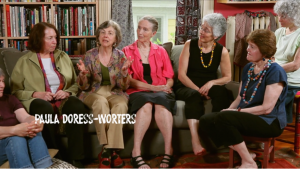She’s Beautiful When She’s Angry directed by Mary Dore combines archival images and footage, interviews, skillful editing, and text to create a powerful narrative of the ways in which women have fought for their rights and resisted patriarchal inertia.

The introduction is a dynamic compilation of moving images, videos, and text screens with continuous narration by different women. Mary Dore uses this sequence as a hook to catch the viewer’s interest. The text screens introduce new ideas and draws the viewer in with powerful statistics about the feminist movement while also giving historical context–– this provides an overview of what the documentary will address. The upbeat music and the vast collection of media add to the excitement of the hook, with images switching almost every second. One small portion of the introduction even uses lyrical music, but fades it out before cutting back to the audio of an interview with the purpose of not distracting from the content of the interview.
Interviews were mainly conducted in a house setting with the interviewee sitting down being filmed with a still camera, all shots were taken above the waist with warm lighting and a blurred background. On a few occasions interviewees would be walking around or standing up and the camera would follow them around the house. These interviews were more informal, and the camera could have been smoother. The interviewee would constantly be talking about something but the documentary would cut to a moving picture or video, often including archival material. There were several interviewees, but they were all shown throughout the documentary so that multiple women spoke about multiple issues.
On a few occasions interviewees would be walking around or standing up and the camera would follow them around the house. These interviews were more informal, and the camera could have been smoother. The interviewee would constantly be talking about something but the documentary would cut to a moving picture or video, often including archival material. There were several interviewees, but they were all shown throughout the documentary so that multiple women spoke about multiple issues.

Each time an interviewee was shown on screen, their name would be displayed with them, and since all interviewees were shown multiple times throughout the documentary, Dore made sure to display their name every instance they were on screen, despite being introduced earlier in the documentary.
In this sense, the editing was stellar in transitioning from multiple types of media, like videos, interview footage, and moving images very frequently yet very smoothly. Oftentimes an interview scene would cut to an archival image or a snippet of archival footage related to the topic at hand. For example, the section of the documentary discussing abortion cuts from an archival photograph of Judith Arcana in her younger years, participating in the Jane Collective, to interview footage of her speaking about her experience. Dore cuts from Arcana’s interview to footage of instruments used for abortion and women involved in the Jane Collective every couple seconds or so in order to keep the documentary visually interesting. Many of the images shown with the audio from the interviews are presented with the Ken Burns effect to focus on a specific aspect of the image, often times zooming in on a person’s face or the words of a particular sign.

However, sometimes there would be still images that simply moved without ever zooming or focusing in on a particular part of the photo. Every topic would include multiple people narrating the same topic in a back-and-forth manner, which was effective in conveying a particular message, like abortion or unequal pay, because there were multiple perspectives.
Dore wanted to provide viewers with a historical understanding of the feminist movement and help them understand the hardships facing women prior to the 1970s. She is able to convey her message so powerfully not just by extensive research to find all the archival footage but because of the way she combines archival footage with interviewees who were in those pictures or videos.  The connection she creates between the past and present throughout the documentary helps her close with talking about the presentand future. At the very end of her documentary, Dore mentions progress that has been made because of the feminist movement but also inequalities that are still present.
The connection she creates between the past and present throughout the documentary helps her close with talking about the presentand future. At the very end of her documentary, Dore mentions progress that has been made because of the feminist movement but also inequalities that are still present.
